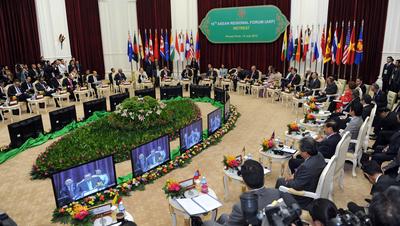Despite these similarities, RCEP has key differences from other agreements currently making up the ‘noodle bowl’ of Asian trade agreements.
The objective of RCEP is to attain a comprehensive and mutually beneficial economic partnership agreement that involves deeper engagement than the existing ASEAN FTAs. Working groups involving ASEAN member states and FTA partners on trade in goods, trade in services, and investment have already been established.
Instead of working with a pre-determined membership, RCEP is based on open accession, which would enable any of the ASEAN FTA partners (China, South Korea, Japan, India and Australia-New Zealand) to participate, either from the outset or when they are ready to join at a later date. The arrangement is also open to any other external economic partners.
RCEP is expected to help further entrench ASEAN centrality, which is challenged by the economic cooperation arrangements rapidly evolving in the region. Moreover, RCEP, based on the ‘ASEAN++’ formula, can be seen as a compromise between EAFTA, which is based on the ASEAN+3 formula and thus favoured by China, and CEPEA, which is based on the ASEAN+6 grouping and thus favoured by Japan.
ASEAN works on a principle of ‘all for one and one for all’, but several regional trade-integration processes, such as the Trans-Pacific Partnership (TPP) and APEC’s Free Trade Area of the Asia Pacific, do not include all ASEAN member states.
The TPP covers not only those issues included in a regular FTA, but also provisions that are crucial for the next wave of economic integration. Certain provisions will be difficult for developing countries to satisfy. In contrast, RCEP’s flexibility — for example, allowing for decisions to be made through any agreed modality and enabling special and differential treatment of ASEAN members — enables a more generous consideration of each state’s needs. In addition, China and India are not presently part of the TPP negotiations. If either or both of these economies joined RCEP, it could be further differentiated from the TPP.
RCEP needs to maximise benefits and lower costs for business. To do this, RCEP should be consistent with existing WTO rules; involve comprehensive coverage of WTO-plus issues; be open to new members; and focus on domestic structural reforms, which are key to the implementation of liberalisation measures. The agreement should reflect the interests of the private sector, especially regarding ‘behind the border’ integration measures, which would increase the usefulness of the initiative.
RCEP will introduce a new choice to the trade-policy marketplace. RCEP should encourage rationalisation and flexibility of rules of origin (ROOs). It is believed that gains can be made from pursuing a simplified approach to ROOs in East Asia involving harmonised ROOs, co-equality of rules and cumulation of value contents. RCEP should be able to adopt the best practices in ROO administration from East Asia and other parts of the world that particularly aim to lower transaction and time costs.
RCEP could also have an impact on the area of trade in services. Liberalising the services sector is a very sensitive issue for many nations. It would perhaps be more appropriate for RCEP to adopt a sector-wise liberalisation process, identifying the sectors with the greatest potential to generate results quickly (for example, the tourism sector).
Finally, RCEP should learn from the experiences of other regional cooperation initiatives in East Asia. For example, the problem of non-tariff barriers should be comprehensively addressed. If some non-tariff barriers are necessary, RCEP must develop regional standards, streamline and harmonise licensing and customs procedures, and develop common approaches to testing methods and conformity assessments.
RCEP is envisioned to enhance market access with due consideration given to its members’ stages of economic development. This is likely to be appealing for ASEAN and other developing countries in the region, as opposed to the ‘no gold standard, no deal’ approach adopted in other fora, such as the WTO. But much depends on ASEAN’s efforts to form an ASEAN Economic Community (AEC) by 2015 and beyond. If ASEAN aims to play a key role in efforts toward global economic rebalancing, it is important for the region to deliver on its promises under the AEC Blueprint.
It remains to be seen how the multi-track and multi-speed arrangements currently taking shape in Asia progress. We may see the APEC, TPP and RCEP tracks continue in parallel with friendly rivalry. But in the long run, policy makers may have to look for ways for them to develop complementarily, in order to optimise member economies’ resources and to achieve a better distribution of benefits among stakeholders.
Sanchita Basu Das is a Fellow and Lead Researcher of Economic Affairs at the ASEAN Studies Centre, ISEAS, Singapore, and Coordinator of the Singapore APEC Study Centre.
A version of this article first appeared in ISEAS Perspective.

